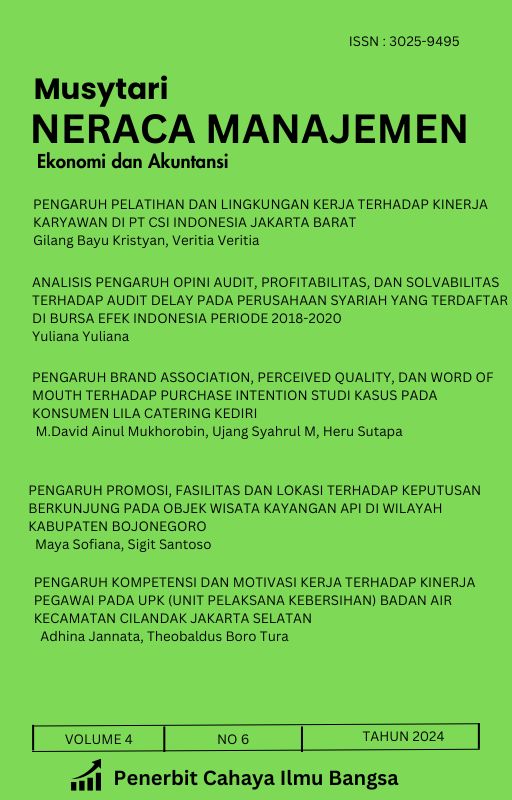ANALISIS PENGARUH BALAS JASA PEKERJA TETAP, UPAH PEKERJA KONSTRUKSI, DAN PERTUMBUHAN PRODUKSI INDUSTRI MIKRO DAN KECIL TERHADAP PDB INDONESIA: PENDEKATAN ARDL TAHUN 2015–2023
Published 2025-06-17
Keywords
- ARDL,
- Indonesia GDP,
- Workers' Compensation,
- Micro and Small Industry,
- BPS
- Quarterly Data,
- Time Series,
- EViews 12 ...More
How to Cite
Abstract
This study aims to analyze the effect of permanent workers' compensation, construction workers' wages, and production growth of micro and small industries on Indonesia's Gross Domestic Product (GDP) using the Autoregressive Distributed Lag (ARDL) approach in the 2015-2023 period. The data used is annual time series data obtained from the Central Bureau of Statistics (BPS). The analysis process begins with a data stationarity test using the first difference method to ensure integration of the appropriate order. Furthermore, Johansen cointegration test was conducted to detect the existence of a long-term relationship between variables. Optimum lag selection is done based on the lowest Akaike Information Criterion (AIC) value criteria, with the best model obtained in ARDL (4,0,4). The Bound Test cointegration analysis confirmed the existence of a long-run relationship between the variables under study. The ARDL model estimation then produces long-run and short-run equations which show that permanent workers' remuneration and production growth of micro and small industries have a significant influence on GDP in the long run. Meanwhile, construction workers' wages show a significant influence in the short run. Assumption tests such as normality, heteroscedasticity, and autocorrelation tests are conducted to ensure the validity of the model. In addition, the model stability test using the CUSUM test shows that the model is in a stable condition during the observation period. Finally, a forecast of the trend of Indonesia's GDP is conducted based on the model that has been built. The results of this study provide policy implications that improving the welfare of permanent workers and strengthening the micro and small industry sector are key factors in supporting national economic growth.
References
- Arifin, R., Sari, N. P., & Hartono, A. (2022). Pengaruh Pendapatan Pekerja Formal Terhadap PDB Indonesia: Pendekatan ARDL. Jurnal Ekonomi dan Pembangunan Indonesia, 23(2), 113–124. https://doi.org/10.24843/JEDI.2022.v23.i02.p03
- Asmarani, D. & Yanuar, A. (2021). Upah Minimum, Angkatan Kerja dan PDB: Analisis Data Panel di Indonesia. Jurnal Kajian Ekonomi dan Kebijakan Publik, 12(1), 33–45. https://doi.org/10.15294/jekp.v12i1.31245
- Astuti, S., & Permana, H. (2022). Analisis pengaruh belanja pemerintah dan pajak terhadap pertumbuhan ekonomi di Indonesia menggunakan model ARDL. Jurnal Kebijakan Ekonomi, 18(1), 77–89. https://doi.org/10.24843/JKE.2022.v18.i01.p07
- Badan Pusat Statistik. (2023). [Seri 2010] (2) PDB Triwulanan Atas Dasar Harga Konstan menurut Pengeluaran (milyar rupiah). https://www.bps.go.id/id/statistics-table/2/MTk1NiMy/-seri-2010--2--pdb-triwulanan-atas-dasar-harga-konstan-menurut-pengeluaran--milyar-rupiah-.html
- Badan Pusat Statistik. (2023). Indeks Triwulanan Balas Jasa Pekerja Tetap dan Upah Pekerja Harian Konstruksi menurut Provinsi (2016=100). https://www.bps.go.id/id/statistics-table/2/NTUwIzI=/indeks-triwulanan-balas-jasa-pekerja-tetap-dan-upah-pekerja-harian-konstruksi-menurut-provinsi--2016-100-.html
- Badan Pusat Statistik. (2023). Pertumbuhan Produksi Triwulanan (q-to-q) Industri Skala Mikro dan Kecil menurut Provinsi (persen). https://www.bps.go.id/id/statistics-table/2/NDA0IzI=/pertumbuhan-produksi-triwulanan-q-to-q-industri-skala-mikro-dan-kecil-menurut-provinsi--persen-.html
- Hapsari, M. D., & Mahmudah, U. (2019). Dampak upah sektor konstruksi terhadap pertumbuhan ekonomi di Indonesia. Jurnal Ekonomi Pembangunan, 17(2), 150–163. https://doi.org/10.22219/jep.v17i2.10084
- Hapsari, M. I., & Nugroho, A. A. (2021). Analisis pengaruh PDB, inflasi, dan tenaga kerja terhadap pengangguran di Indonesia. Jurnal Ekonomi dan Perencanaan Pembangunan, 11(1), 53–62.
- Lewis, W. A. (1954). Economic development with unlimited supplies of labour. The Manchester School, 22(2), 139–191. https://doi.org/10.1111/j.1467-9957.1954.tb00021.x
- Lucas, R. E. (1988). On the mechanics of economic development. Journal of Monetary Economics, 22(1), 3–42. https://doi.org/10.1016/0304-3932(88)90168-7
- Mankiw, N. G. (2016). Macroeconomics (9th ed.). New York, NY: Worth Publishers.
- Nazamuddin, N., & Herlina, S. (2020). Pengaruh upah minimum dan investasi terhadap pertumbuhan ekonomi di Indonesia. Jurnal Ekonomi dan Studi Pembangunan, 21(2), 215–226.
- Nugroho, S., & Rahayu, A. (2020). Pengaruh pendapatan tenaga kerja dan pengeluaran konsumsi rumah tangga terhadap PDB Indonesia. Jurnal Ekonomi dan Keuangan Indonesia, 14(3), 213–227. https://doi.org/10.21002/jeki.v14i3.2020
- Pesaran, M. H., Shin, Y., & Smith, R. J. (2001). Bounds testing approaches to the analysis of level relationships. Journal of Applied Econometrics, 16(3), 289–326. https://doi.org/10.1002/jae.616
- Pramudita, D., & Susilo, D. (2021). Kontribusi industri kecil terhadap pertumbuhan ekonomi regional di Indonesia. Jurnal Ekonomi dan Pembangunan Daerah, 12(1), 55–67. https://doi.org/10.47268/jepd.v12i1.117
- Putri, M. D., & Nugroho, A. Y. S. (2020). Pengaruh Sektor Konstruksi Terhadap Pertumbuhan Ekonomi di Indonesia: Pendekatan ARDL. Jurnal Ekonomi dan Pembangunan, 18(2), 155–170. https://doi.org/10.22219/jep.v18i2.11220
- Romer, P. M. (1990). Endogenous technological change. Journal of Political Economy, 98(5, Part 2), S71–S102. https://doi.org/10.1086/261725
- Tambunan, T. T. H. (2019). Usaha Mikro, Kecil dan Menengah di Indonesia: Isu-Isu Penting. Jakarta: LP3ES.
- Wahyuni, R. S., & Wardani, D. K. (2021). Pengaruh upah minimum dan tenaga kerja terhadap pertumbuhan ekonomi Indonesia. Jurnal Ekonomi dan Bisnis, 19(1), 101–114. https://doi.org/10.31941/jebi.v19i1.1345
- Wahyuni, S., & Fitriani, A. (2023). Industri Mikro dan Kecil sebagai Penggerak Ekonomi Daerah di Indonesia. Jurnal Ekonomi Daerah, 15(1), 91–105. https://doi.org/10.29313/jed.v15i1.4221

